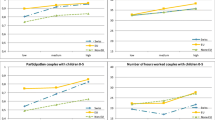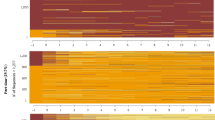Abstract
Multigenerational disadvantage is related to patterns of family formation because divergent childbearing pathways widen socioeconomic differences in children’s resources. Socioeconomic differences in the timing of first family formation (age at first birth) in Australia have been found using educational attainment as a proxy for socioeconomic status. International evidence suggests that income may be a more direct measure, however its use is confounded by its relationship with work hours. Using Australian prospective panel data, and discrete-time hazard models with time-varying effects, this paper explores how income and work hours influence first birth timing for Australian women. The results indicate that higher gross weekly wages reduce the risk of first birth at younger ages and increase the risk at older ages. The hourly wage and work hours components of gross weekly wages are then separated, and the independent effects on first birth timing are analysed. There is a clearer effect of higher wages, while working part-time is significantly associated with a higher risk of first birth at any age. The results suggest that while some employment facilitates childbearing, there are socioeconomic differences in the timing of first family formation for Australian women and that accounting for work hours may be important when examining the effect of income.

Source: Author’s calculations based on HILDA Release 13 (Melbourne Institute 2014)

Source: Author’s calculations based on HILDA Release 13 (Melbourne Institute 2014)

Source: Author’s calculations based on HILDA Release 13 (Melbourne Institute 2014)
Similar content being viewed by others
References
ABS. (2014a). Births, Australia, 2013. Cat. No. 3301.0. Australian Bureau of Statistics. http://www.abs.gov.au/AUSSTATS/abs@.nsf/mf/3301.0. Accessed 13 Mar 2015.
ABS. (2014b). Consumer price index, Australia, December, 2013 (Table 1 and 2.CPI: All groups, index numbers and percentage changes). Cat. No. 6401.0. Australian Bureau of Statistics. http://www.abs.gov.au/AUSSTATS/abs@.nsf/DetailsPage/6401.0Dec%202013?OpenDocument. Accessed 24 May 2015.
ABS. (2015). Labour force, Australia, Feb 2015 (Table 01. Labour force status by Sex—Seasonally adjusted). Cat. No. 6202.0. Australian Bureau of Statistics. http://www.abs.gov.au/AUSSTATS/abs@.nsf/DetailsPage/6202.0Feb%202015?OpenDocument. Accessed 13 Mar 2015.
Andersson, G., Kreyenfeld, M., & Mika, T. (2014). Welfare state context, female labour-market attachment and childbearing in Germany and Denmark. Journal of Population Research, 31, 287–316.
Australian Bureau of Statistics (ABS). (2010). Australian Social Trends December 2010. One for the country: recent trends in fertility. Cat. No. 4102.0. Australian Bureau of Statistics. http://www.abs.gov.au/AUSSTATS/abs@.nsf/Lookup/4102.0Main+Features10Dec+2010. Accessed 13 Mar 2015.
Batson, C. (2012). Contemporary fertility patterns and first-birth timing among Mexican-origin women. Hispanic Journal of Behavioral Sciences, 35(2), 174–193.
Beaujot, R., Ravanera, Z., & Burch, T. (2007). Toward and HRSDC family research framework. PSC Discussion Paper Series, 21(2), Article 1.
Becker, G. (1993). A treatise on the family. Cambridge, MA: Harvard University Press.
Bloeman, H., & Kalwij, A. (1996). Female labor market transitions and the timing of births: A simultaneous analysis of the effects of schooling. Labour Economics, 8, 593–620.
Brand, J., & Davis, D. (2011). The impact of college education on fertility: Evidence for heterogeneous effects. Demography, 48, 863–887.
Bredtmann, J., Jochen, K., & Schaffner, S. (2009). Women’s fertility and employment decisions under two political systems: Comparing East and West Germany before reunification. Ruhr economic papers, No. 149. Rheinisch-Westfälisches Institut für Wirtschaftsforschung. http://core.ac.uk/download/pdf/6271834.pdf. Accessed 24 Dec 2014.
Budig, M. (2003). Are women’s employment and fertility histories interdependent? An examination of causal order using event history analysis. Social Science Research, 32, 376–401.
Busetta, A., & Giambalvo, O. (2014). The effect of women’s participation in the labour market on the postponement of first childbirth: A comparison of Italy and Hungary. Journal of Population Research, 31, 151–192.
De Vaus, D. (2002). Marriage, births and fertility. Family Matters, 63, 36–39.
Ekert-Jaffe, O., Joshi, H., Lynch, K., Mougin, R., & Rendall, M. (2002). Fertility, timing of births and socio-economic status in France and Britain: Social policies and occupational polarization. Population, 57, 485–518.
Esping-Andersen, G. (1999). Social foundations of postindustrial economies. New York: Oxford University Press.
Esping-Andersen, G., & Billari, F. (2015). Re-theorizing family demographics. Population and Development Review, 41(1), 1–31.
Gray, E., & Evans, A. (2017). Geographic variation in parity progression in Australia. Population, space and place, 1–11. Early view. http://dx.doi.org/10.1002/psp.2080.
Heard, G., & Arunachalam, D. (2011). Socioeconomic differences in family formation: Recent Australian trends. New Zealand Population Review, 37, 125–143.
Hullen, G. (2000). The effects of education and employment on marriage and first birth. FFS Flagship conference paper 2000. Economic Commission for Europe. http://www.unece.org/pau/_docs/ffs/FFS_2000_FFConf_ContriHullen.pdf. Accessed 26 November 2014.
Jones, L., Schoonbroodt, A., & Tertilt, M. (2008). Fertility theories: Can they explain the negative fertility-income relationship? Resource document. University of Minnesota Department of Economics. http://www.econ.umn.edu/~lej/papers/JonesSchoonbroodtTertilt2008.pdf. Accessed 6 May 2015.
Kalwij, A. (2000). The effect of female employment status on the presence and number of children. Journal of Population Economics, 13(2), 221–239.
Klasen, S., & Launov, A. (2003). Analysis of the determinant of fertility decline in the Czech Republic. IZA Discussion paper series, No. 870. Institute for the Study of Labor. http://papers.ssrn.com/sol3/papers.cfm?abstract_id=446320. Accessed 24 December 2014.
Kravdal, O. (1994). The importance of economic activity, economic potential and economic resources for the timing of first births in Norway. Population Studies, 48(2), 249–267.
Lundberg, S., & Rose, E. (2000). Parenthood and the earnings of married men and women. Labour Economics, 7, 689–710.
Mahon, R., Bergqvist, C., & Brennan, B. (2016). Social policy change: Work-family tensions in Sweden, Australia and Canada. Social Policy & Administration, 50(2), 165–182.
Martin, S. (2000). Diverging fertility among U.S. women who delay childbearing past age 30. Demography, 37(4), 523–533.
Matysiak, A., & Vignoli, D. (2013). Diverse effects of women’s employment on fertility: Insights from Italy and Poland. European Journal of Population, 29, 273–302.
McDonald, P. (2000). Gender equity, social institutions and the future of fertility. Journal of Population Research, 17, 1–16.
McDonald, P. (2014). Population: An ever present policy issue. In A. McClelland & P. Smyth (Eds.), Social Policy in Australia: Understanding for Action (pp. 127–142). Australia: Oxford University Press.
McLanahan, S. (2004). Diverging destinies: How children are faring under the second demographic transition. Demography, 41(4), 607–627.
Melbourne Institute. (2014). Unit record data from the Household, Income and Labour Dynamics in Australia (HILDA) Survey—Release 13. Melbourne Institute of Applied Economic and Social Research, University of Melbourne. Data provided by secure, personal correspondence. Accessed 16 Feb 2015.
Merlo, R. (1995). First birth timing in Australia. Journal of the Australian Population Association, 12(2), 131–146.
Mills, M., Rindfuss, R., McDonald, P., & te Velde, E. (2011). Why do people postpone parenthood? Reasons and social policy incentives. Human Reproduction Update, 17(6), 848–860.
Pocock, B., Charlesworth, S., & Chapman, J. (2013). Work-family and work-life pressures in Australia: advancing gender equality in “good times”? International Journal of Sociology and Social policy, 33(9/10), 594–612.
Ravanera, Z., Fernando, R., & Burch, T. (2006). Inequality and the life course: Differentials in Trajectories and Timing of Transitions of Canadian Women. PSC Discussion Paper Series, 20(3), Article 1.
Rendall, M., DeRose, A., Kreute, F., Lappegard, T., Reeder, L., Ronsens, M., & Toulemon, L. (2013). Employment impacts on entry to parenthood in different family-policy regimes. HILDA conference 2013 paper. Melbourne Institute of Applied Economic and Social Research, University of Melbourne. https://www.melbourneinstitute.com/downloads/conferences/HILDA_2013/HILDA_2013_papers/Rendall,%20Michael_final%20paper.pdf. Accessed 19 Nov 2014.
Rendall, M., Ekert-Jaffe, O., Joshi, H., Lynch, K., & Mougin, R. (2009). Universal versus economically polarized change in age at first birth: A French-British comparison. Population and Development Review, 35(1), 89–115.
Rindfuss, R., Guilkey, D., Morgan, S., Kravdal, O., & Guzzo, K. (2007). Child care availability and first-birth timing in Norway. Demography, 44(2), 345–372.
Santow, G., & Bracher, M. (2001). Deferment of the first birth and fluctuation fertility in Sweden. European Journal of Population, 17, 343–363.
Schmitt, C. (2012). A cross-national perspective on unemployment and first births. European Journal of Population, 28, 303–335.
Singer, J., & Willett, J. (1993). It’s about time: Using discrete-time survival analysis to study duration and the timing of events. Journal of Educational Statistics, 18(2), 155–195.
Summerfield, M., Freidin, S., Hahn, M., Li, N., Macalalad, N., Mundy, L, Watson, N., Wilkins, R., & Wooden, M. (2014). HILDA user manual—release 13. Resource document. Melbourne Institute of Applied Economic and Social Research, University of Melbourne. http://www.melbourneinstitute.com/downloads/hilda/User%20Manual/HILDA%20User%20Manual%20Release%2013.1.pdf. Accessed 16 Feb 2015.
Vikat, A. (2004). Women’s labor force attachment and childbearing in Finland. Demographic Research, Special Collection, 3, 177–212.
Author information
Authors and Affiliations
Corresponding author
Additional information
This paper uses unit record data from the Household, Income and Labour Dynamics in Australia (HILDA) Survey. The HILDA Project was initiated and is funded by the Australian Government Department of Social Services (DSS), and is managed by the Melbourne Institute of Applied Economic and Social Research (Melbourne Institute). The findings and views reported in this paper, however, are those of the author and should not be attributed to either DSS or the Melbourne Institute.
Rights and permissions
About this article
Cite this article
Kingsley, M. The influence of income and work hours on first birth for Australian women. J Pop Research 35, 107–129 (2018). https://doi.org/10.1007/s12546-018-9200-4
Published:
Issue Date:
DOI: https://doi.org/10.1007/s12546-018-9200-4




